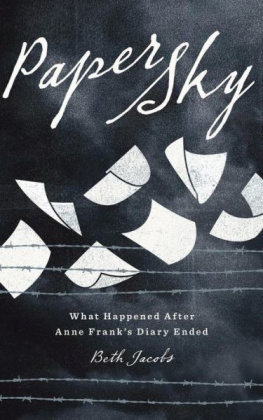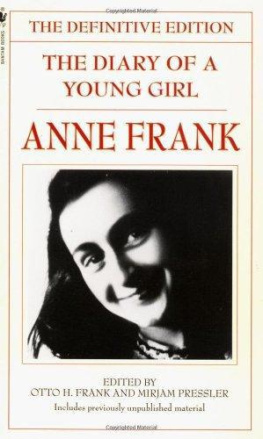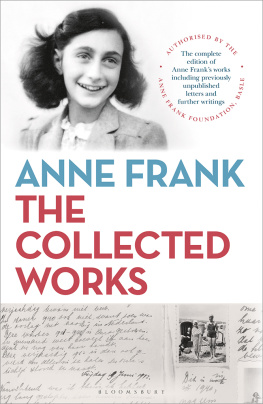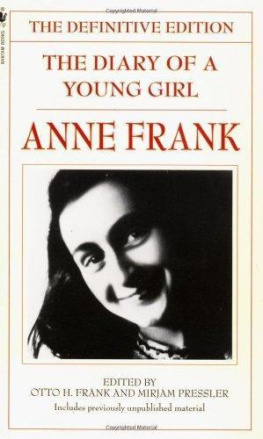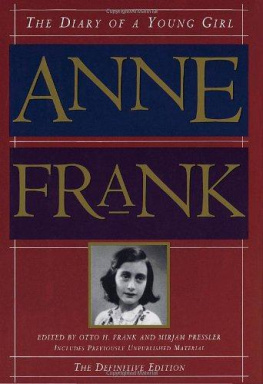The Anne Frank House - Anne Frank in the Secret Annex: Who Was Who?
Here you can read online The Anne Frank House - Anne Frank in the Secret Annex: Who Was Who? full text of the book (entire story) in english for free. Download pdf and epub, get meaning, cover and reviews about this ebook. year: 2016, publisher: The Anne Frank House, genre: Non-fiction. Description of the work, (preface) as well as reviews are available. Best literature library LitArk.com created for fans of good reading and offers a wide selection of genres:
Romance novel
Science fiction
Adventure
Detective
Science
History
Home and family
Prose
Art
Politics
Computer
Non-fiction
Religion
Business
Children
Humor
Choose a favorite category and find really read worthwhile books. Enjoy immersion in the world of imagination, feel the emotions of the characters or learn something new for yourself, make an fascinating discovery.

- Book:Anne Frank in the Secret Annex: Who Was Who?
- Author:
- Publisher:The Anne Frank House
- Genre:
- Year:2016
- Rating:5 / 5
- Favourites:Add to favourites
- Your mark:
- 100
- 1
- 2
- 3
- 4
- 5
Anne Frank in the Secret Annex: Who Was Who?: summary, description and annotation
We offer to read an annotation, description, summary or preface (depends on what the author of the book "Anne Frank in the Secret Annex: Who Was Who?" wrote himself). If you haven't found the necessary information about the book — write in the comments, we will try to find it.
Anne Frank in the Secret Annex: Who Was Who? — read online for free the complete book (whole text) full work
Below is the text of the book, divided by pages. System saving the place of the last page read, allows you to conveniently read the book "Anne Frank in the Secret Annex: Who Was Who?" online for free, without having to search again every time where you left off. Put a bookmark, and you can go to the page where you finished reading at any time.
Font size:
Interval:
Bookmark:
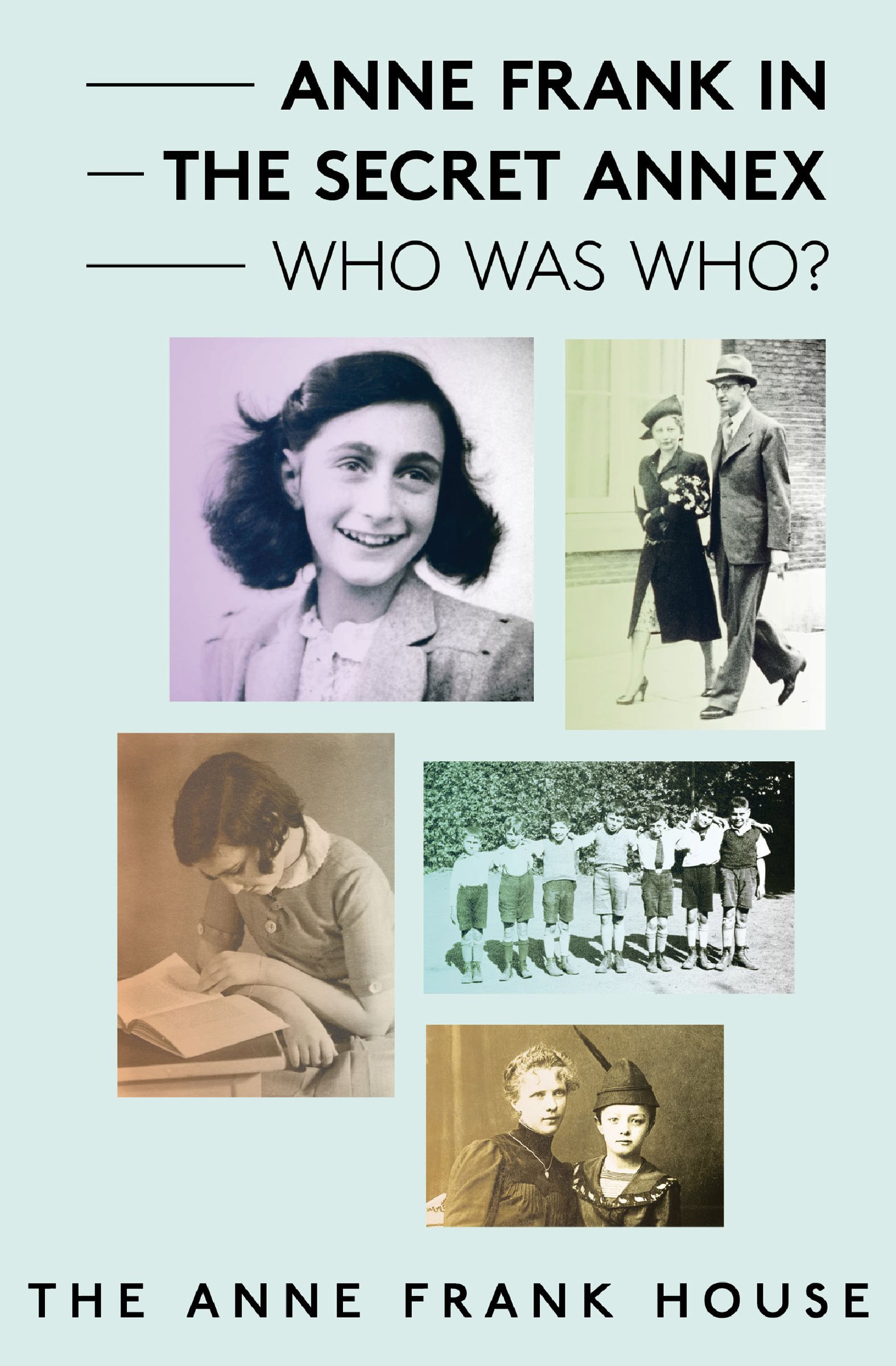


Foreword
During World War II, in what is now known as the Secret Annex, located in Amsterdam at Prinsengracht 263, eight Jews remained in hiding for more than two years: Otto; Edith; Margo and Anne Frank; Hermann; Auguste and Peter van Pels; and Fritz Pfeffer. Five people, for whom taking on this dangerous task felt only normal, helped them: Johannes Kleiman, Victor Kugler, Bep Voskuijl, and Miep and Jan Gies.
In her diary, Anne Frank gave faces to the eight people hiding in the Secret Annex and their five helpers. The period she lived with themJuly 1942 to August 1944was intense. Her youthful outlook and the circumstances of the war era strongly colored the portraits she created. Anne gave all of the characters pseudonyms in her diary, except for her parents and and her sister.
But who were these people and where did they come from? What were their daily lives like during the occupation? What did these people in hiding eat? What did they do all day? And how did their helpers manage to feed eight extra mouths while carrying out their duties at the office, without their activities being noticed? Did they stay in contact after the war?
For the first time, this book outlines the lives of those in hiding and their helpers, both during and after their time in the Secret Annex, in thirteen personal portraits. There were also other people active in and around Prinsengracht 263, such as warehouse employees, suppliers, and representatives. To date, their roles have never been described.
The Anne Frank Foundation has spent many years researching everyone involved. This publication includes their latest discoveries, as well as many new photographs. We hope that this ebook will form a valuable addition to the existing literature about Anne Frank and the Secret Annex.
Ronald Leopold
Executive Director, Anne Frank House
A Brief History
Germanys defeat in World War I in 1918 brought the country to its knees. It wasnt only the heavy war reparations imposed by the victorious countries on Germany that dealt such a crushing blow. The hyperinflation of 1923 marked a low point in Germanys crisis. The United States responded by offering loans that were intended to help pay off the war debt, enabling Germany to enjoy relative prosperity and moderate political stability until 1929. In that year, however, a worldwide economic crisis struck, causing Germanys problems to take a sharp turn for the worse. The American loans were withdrawn, many companies went bankrupt, and unemployment spiraled. This produced a climate in which the extreme nationalist ideas of Adolf Hitler and his Nationalsozialistische Deutsche Arbeiterpartei (NSDAP), or the Nazi Party, found fertile soil. The Nazis blamed all the political and economic problems on the Jews.
After the appointment of Hitler as chancellor on January 30, 1933, and the subsequent victory of the National Socialists in the parliamentary and municipal elections, the curtain fell on the young German republic. The persecution of Hitlers political opponents had already been set in motion. As the years passed, the situation became increasingly threatening for the Jews as well. Countless regulations and ordinances turned them into second-class citizens. Jews were not allowed to practice certain professions, for example. Their children had to attend separate schools, and the publication of Jewish newspapers and magazines was declared illegal. Disabled people were also persecuted, as were the Roma and the Sinti, homosexuals, and Jehovahs Witnesses. Later on, most of these regulations were also imposed in countries occupied by Germany, including the Netherlands.
On the Run
After Hitler came to power, a large number of German Jews fled their homeland. Tens of thousands went to the Netherlands. Among them were Otto and Edith Frank and their daughters, Margot and Anne, as well as Hermann and Auguste van Pels and their son, Peter. The eighth occupant of the Secret Annex, Fritz Pfeffer, first tried to emigrate from Germany to South America, but in the end, he too ended up in the Netherlands.

Letter from the American Consulate in Rotterdam to Hermann van Pels, dated April 25, 1939, with confirmation of registration of the van Pels family as immigrants. Because of the high number of applicants, the waiting time is indefinite.
For some refugees, the Netherlands was meant to be a stopover point in their search for refuge. The Frank and Van Pels families also attempted to leave the country. In 1937, Otto Frank tried to set up a business in England, but his efforts failed. In 1938, he applied for emigration to the United States but was turned down. After Ediths unmarried brothers succeeded in getting to America, Otto made a few more frantic attempts to immigrate to America or Cuba in 1941. But due to the growing stream of refugees, the excessive red tape, and the everchanging demands, his requests came to naught. The Van Pels family had been on a waiting list to apply for a visa to the United States since 1939, and Fritz Pfeffer was hoping to go to Australia, Aruba, or Chile.
When all these attempts failed, the Franks had nowhere left to go. Finally, just a little more than two years after the German invasion of the Netherlands, they decided to go into hiding.
The Occupation and the Anti-Jewish Regulations
On May 10, 1940, Nazi Germany invaded the Netherlands. After a four-day battle and the devastating bombing of Rotterdam, the country capitulated. The Dutch government and Queen Wilhelmina fled to London, where they made radio broadcasts via Radio Oranje through the BBC to raise the spirits of their countrymen. Listening had to be done in secret because the German occupiers had banned the English stations, and it wasnt long before the Dutch were required to turn in their radios.
The Nazis also introduced more and more anti-Jewish regulation in the Netherlands. The names of the approximately 140,000 Jews living in the Netherlands were entered into a central Jewish registry. They all had to wear a visible on their clothing and turn in their bicycles,and they could no longer travel by tram or attend the theater or cinema; be out on the street or sit in their own gardens between eight in the evening and six in the morning; marry Gentiles; or participate in public sports. Jewish children had to go to Jewish schools. All these regulations made it impossible to live a normal life.

In September 1941, signs like this one, Prohibited for Jews, began appearing in parks, cafs, restaurants, and theaters.
But the Nazis would go much further. At a secret meeting in January 1942 at Berlin Wansee, the (the Final Solution). In July of that year, the systematic implementation of the Nazi plans for the deportation and extermination of millions of European Jews had begun.
Opekta, Pectacon, Gies & Co.
The Franks, a young Frankfurt family of prominent social standing, came to the Netherlands in 1933 so that Otto Frank could set up a branch of Opekta, a business Otto had learned about from his brother-in-law Erich Elias, who worked for the company in Basel. Opekta manufactured and sold pectin, a gelatinous substance used to make jam, and Ottos job was to corner the Dutch retail market. He rented commercial space on Nieuwezijds Voorburgwal and hired an office staff that included Victor Kugler and Miep Santrouschitz, as well as a couple of warehouse workers. In 1937, he took on Bep Voskuijl as secretary. Later, Beps father, Johannes Voskuijl, joined the firm as the warehouse supervisor.
Font size:
Interval:
Bookmark:
Similar books «Anne Frank in the Secret Annex: Who Was Who?»
Look at similar books to Anne Frank in the Secret Annex: Who Was Who?. We have selected literature similar in name and meaning in the hope of providing readers with more options to find new, interesting, not yet read works.
Discussion, reviews of the book Anne Frank in the Secret Annex: Who Was Who? and just readers' own opinions. Leave your comments, write what you think about the work, its meaning or the main characters. Specify what exactly you liked and what you didn't like, and why you think so.



